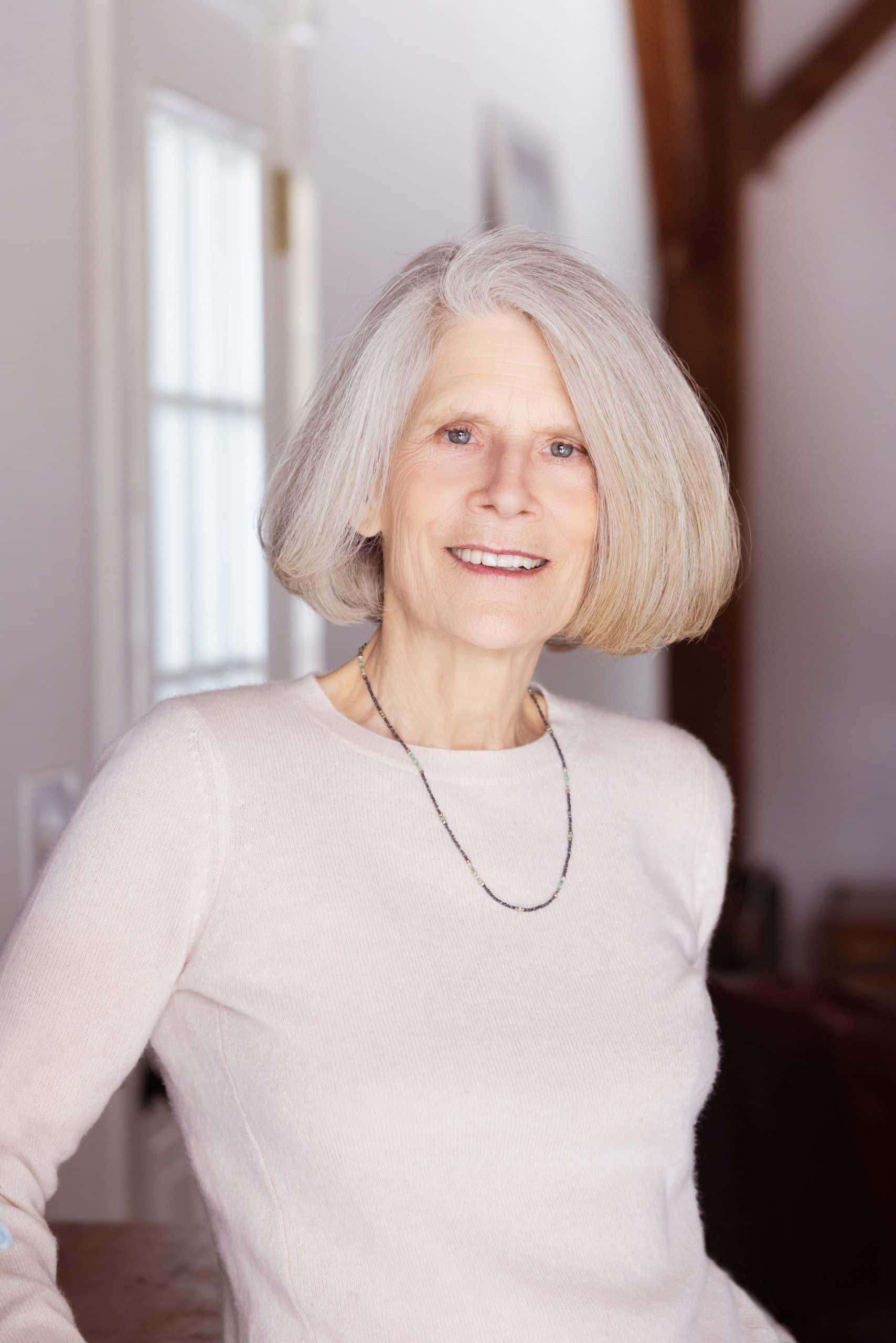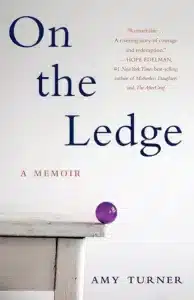Note: The below is adapted from Amy Turner’s acclaimed memoir, On the Ledge, published by She Writes Press.
Arriving within 30 months of each other, my brothers, Harold and Jimmy, and I had been a force from the beginning. We’d vanquished babysitter after babysitter. Live-in housekeepers escaped in the night, presumably ashamed to admit they were no matches for three toddlers. That we were preverbal had been absolutely no obstacle to our planning and execution. We were invincible. Back then, the three of us were one indestructible piece; even we couldn’t tell where one of us ended and the others began.
On our way to visit our son at college in 2010, Ed and I stopped for lunch. I needed frequent breaks. Just the sight of vehicles speeding by disoriented me. Two months earlier a pickup truck had plowed into me as I was crossing the street. Miraculously, I’d sustained no broken bones, but still suffering from a serious concussion, I probably shouldn’t have been traveling. However, regardless of my dizziness and throbbing head, I was determined to return to normal life.
Ed and I were talking about which of the parents’ activities we’d want to attend when my cell phone rang. Not wanting to talk on my cell in a public place, I sent Jimmy’s call to voicemail and retrieved the message from there.
“Ame, call me as soon as you can. Umm, it’s important.”
I looked at Ed and sighed. After 30 years of marriage, he knew my family as well as any of us knew each other. “Harold?”
“I’m sure. Oh, God, not now.”
When Jimmy described the policeman coming to his door and asking, “Are you the brother of Harold Turner? I’m sorry to inform you . . . ” I could feel the threads that I thought had frayed to nothing long ago tighten around me in a final, fleeting hug, then snap—one by one.
As a child, I thought that, of the three of us, Harold might be the most special. In one of my parents’ few joint expressions of playfulness, we were each “given” a tune that featured our first names. Although Harold’s song—”Hark the Herald Angels Sing”—was a bit of a stretch, he also had what our family prized above all—a book, actually a series of books, with his name in the title: Harold and the Purple Crayon. Published in 1955, a year after Harold’s birth, the book had been ready for him just as he was ready to be read to. About four-years-old and appearing simply as a black outline on a white background, fictional Harold realized his dreams and evaded perils, by drawing one unbroken line with his large purple crayon. He drew himself to the moon, and escaped a dragon and a drowning. However far away his adventures took him, in the end, he always remembered how to draw himself back to where he most wanted to be: at home, sleeping in his bed, the blanket drawn up to his chin, and his face at peace under a moon perfectly framed in his window.
If I’d heard this news about Harold at any other time in the previous 20 years, I would’ve been sad, but not surprised. What little I knew of Harold’s life during those decades had included his identifying the body of his second wife, who was murdered after she left a bar; moving from apartments to motels; and then alternating between the streets and couches of bar acquaintances slightly less down-and-out than he. Arrested several times for public consumption of alcohol and vagrancy, for years, Harold called only to ask for money—initially polite requests that always ended in angry demands. I still remember my head pounding in rhythm with the percussive and frightening hard C’s—”may not recover normal cognitive function, brain damage due to continuous grand mal seizures electroshock therapy”—as a psychiatrist described Harold’s condition eight years earlier, in 2002. Harold would recover well enough to resume drinking.
As children, Harold, Jimmy, and I were platinum blondes, but Harold’s hair darkened earlier and to a greater degree than ours. In the summer, his light brown freckles gained territory and could almost masquerade as a tan. Invariably, his face also showed red patches where the freckles stopped and the zinc oxide had been hastily applied, if at all. I still picture Harold on the tennis court—straw-blond hair and slightly sunburned face, fighting back tears after losing to his best friend, whose only advantage was a killer instinct.
I remember sitting on my twin bed, as a 15-year-old, facing 14-year-old Harold and 13-year-old Jimmy on the guest bed opposite me, the three of us crouched so far forward that our knees touched. My brothers were whispering in an anxious duet—”Wait, What? Dad was going to jump? That’s why he was gone when we were little?”—when our mother, arriving home from an AA meeting earlier than expected, walked in.
After a moment of stunned silence, she erupted. “Amy, what did you tell them?”
Buoyed by the self-righteousness of a heroine saving her brothers from a lifetime of ignorance and misery (and by the confidence that my psychologist would defend me should my mother punish me), I did the unthinkable in our family: I yelled back.
“I told them about Dad’s suicide attempt and the mental hospital. Dr. Ferdinand just told me. They have the right to know.”
Her yell had been scary enough, but the glare that followed my outburst was chilling. When she barked, “Harold and Jimmy, go to your rooms right now,” they were already scurrying to the door. She stared at me once more then shut the door with enough force to make clear the topic was now closed.
In high school, Harold’s drinking and drug use already had a desperate, determined quality, different from the usual teenage experimentation. He would try anything and was brazen in doing so—sometimes in his room at the top of the back stairs, out of earshot of my parents’ bedroom. While pot was becoming popular in our high school and some kids were using psychedelics, Harold was one of the very few who snorted heroin. How he did this and maintained good enough grades to get into Harvard was hard to fathom.
A week before Harold’s memorial service in Fairfield, Iowa, I began an archaeological dig in our basement to locate his letters to me during the year I spent in Switzerland. Desperately wanting once more to be an 18-year-old girl with a 17-year-old brother, I sat on the basement floor and, as the tears streaked the dust on my face, read them all: “It’s no big deal, Ame. I’m just having fun.”
Had I taken the letters upstairs to read, the dig would have ended there. I would never have noticed an unfamiliar trunk—the kind we had taken to summer camp—its once shiny black surface peeling and gray, its reinforced corners dented, and its metal lock now rusted and disintegrating. When I opened it, I could’ve been peering into Harold’s coffin. There he was—documented in glowing report cards, newspaper clippings of undefeated basketball seasons, tennis trophies, academic awards, childhood drawings, college essays, and postcards from camp.
I examined each artifact, hoping that this autopsy of sorts might pinpoint the source of his suffering. There was the expected anatomy of any academically and athletically gifted student. There were cards for Christmas and Mother’s Day and Father’s Day, the products of obligatory elementary school activities, but then there were others that I am sure no schoolteacher had a hand in: Harold’s thank-you notes to our parents that I would never have written as a child, or as a parent could ever have expected to receive, including—notes for Christmas presents, for a trip to a football game, or for just being “great parents.”
Also in the trunk, in a stack held together by a deteriorating rubber band, were my letters to him. When I saw my rounded, girlish print, I was embarrassed for my 18-year-old self who had thought her naïve threats could solve Harold’s problem—”Mom’s going to kill you if you don’t stop doing drugs.” Yet I realized she had not yet been jaded by the decades of worry and unheeded pleas that would follow.
Most of my memories of Harold’s vulnerability and sweetness had been obliterated by his anger and arrogance, the byproducts of decades of drinking. But as I read a note he’d written at age ten to my parents, “Thank you very much for making Sat. the 25th such a wonderful day, someday I’ll do it for you . . .” and one he’d written eight years later to my father regarding their victory in a crucial doubles match, “Perhaps the time that has passed since our glorious match has wrapped our experience in gold. Whatever the case may be, gold or fool’s gold, I will treasure it the same,” all echoes of his drunken rants were gone. In the silence, I could almost hear the soft beating of his heart.
As Harold told it, during his freshman year at Harvard, he noticed a group of students who—unlike his circle of friends—always looked rested, clear-eyed, and happy. When he asked them why, they said they’d started Transcendental Meditation (TM). Wanting that clarity and peace (and, though he didn’t say it at that time, sobriety), he started right away. With my parents’ blessing, he took time off from college in 1974 to become a TM teacher. After returning from teacher training, his social life mainly involved leading residence courses or watching tapes of Maharishi with other meditators.
But Harold was a “periodic,” like my mother had been, which meant that periods of sobriety were eventually followed by ever-longer stretches of binge drinking.
In 1987, Harold moved to Fairfield, Iowa, the TM organization’s centerpiece in the U.S., with his girlfriend-soon-to-be-wife, hoping, I believe, the influence of meditators might keep him sober. But it wasn’t enough. Whenever my mother, a fixture in AA by then, urged Harold to go to a meeting, he would taunt her, “You were drinking at my age. I’ll stop drinking when you did, when I’m thirty-five. Leave me alone.”
If Harold stopped drinking in 1990 when he turned 35, it wasn’t for long. His marriage broke up two years later, and by 1996 he was married to Trudy, whom he met in a bar. She also had multiple arrests for public intoxication. “She’s really nice, Ame, you would like her,” he’d occasionally slur on my answering machine. I hoped to God his situation wouldn’t get any worse, but one afternoon in early December 1997, I came home to hear him leaving a message—howling himself hoarse—”TRUDY WAS MURDERED! DO YOU KNOW WHAT IT’S LIKE TO IDENTIFY A DEAD BODY? OH GOD, HER FACE.” When I picked up the phone, my shuddering triggered a wave of nausea, as if Harold’s words landed in my gut, not my brain. I tried to ask questions, said I was so sorry, but he just kept yelling. “I was at home. We had an argument. This guy gave her a ride home from the bar… in a DITCH, they found her nude…IN A DITCH! During the next few months, Harold called about once a week to leave the same message, as if for the first time. Eventually I couldn’t force myself to pick up. (Later I would learn that a thirty-seven-year old man, pleaded guilty to Trudy’s murder and was sentenced to fifty years in prison.)
But at the time of Harold’s death fourteen years later, at 56, he had made incredible progress. During his eleven-month term in an Iowa jail for public intoxication (imposed because of his repeat offenses), he had been off anti-seizure medication, cigarettes, and alcohol. Upon Harold’s release, his close friend Jean (whose unwavering dedication to him was much appreciated but often baffling) moved in with him and ensured his abstinence continued. Still compromised physically by his stroke and suffering memory lapses, Harold didn’t have the wherewithal to rebel. Occasionally, though, I’d receive a voice mail from him: “Hey, Ame, I’m with this girl Jean. She’s attractive and all but such a pain. She won’t let me drink, or even smoke.” And so, with the help of the Iowa correctional system and Jean, Harold had accomplished what he hadn’t been able to since he’d been in his twenties: just over a thousand consecutive days of being clean.
I last saw Harold in 2008, in Fairfield, two years before his death and a few months after his jail release. As he told stories from his college days at lunch with Jimmy and me, his joy cast a soft focus on him so that I could no longer make out his receding hairline or the canyons that years of drinking had carved into his face. For a moment, I saw him at 18—by then, six foot two and slim, his once gangly arms and legs had found proportion, making him a natural for dancing, tennis, and basketball—any activity requiring a glide. The images of him in effortless motion are what stay with me: on the dance floor at my wedding, moving with an innate rhythm that belied our physically uptight upbringing; on a tennis court, arcing fluidly through a forehand; and on a basketball court, launching the ball toward the basket with one graceful flick of his palms and fingertips, his body erect, his feet suspended two feet in the air.
In one of my favorite photographs of Harold and me, we’re standing next to each other, smiling, our two-year-old children—his daughter Katherine and my son Matt, born a month apart—playing at our feet. I still marvel that they look more alike than most fraternal twins I know.
As Ed drove the two of us from the Cedar Rapids airport to Fairfield, I closed my eyes to silently practice the remarks I planned to give at Harold’s memorial the following day. But as I began, I suddenly pictured the windshield of the oncoming pickup truck, felt the same vulnerability that had buzzed through me moments before it struck me. I was shivering. It was as if Harold’s passing had ripped off protective layers so deeply buried I hadn’t known they existed until they were gone. I squelched a sob. My primal connection to him, I realized, had less to do with our being 13 months apart than with our seeking a sense of security from each other that our alcoholic mother and suicidal father couldn’t provide in those early years. I let myself cry, and Ed reached over to rub my shoulder. I hoped Harold and I had been forgiven, and that whatever pain we’d caused each other—his drinking, my inability and, at times, unwillingness to help him—could no longer obscure what we’d felt since his birth: a bond that, had we known the word for it back then, would have been love.
Soon after we arrived in Fairfield, Jean recounted the story of Harold’s death. The night before, Harold had eaten little and told her that he’d just had two great telephone conversations: one with his daughter, Katherine, and the other with Jimmy, who had told him to “hold fast.” Jean was happy that Harold had had a chance to speak to them but his cell phone indicated that no calls had been made or received.
The following morning, Jean had left early, after first making sure Harold was warmly covered in bed. When she returned three hours later, she’d found Harold on the floor. As she described how the duvet had been draped over his body, I envisioned him in a cocoon of white comforter—its edges almost carefully, and perhaps lovingly, tucked under his chin to reveal only his face.
Half-smiling, I shook my head slowly and brushed away the tears sliding over my cheekbones. I was relieved for Harold, and us even more so, that he’d died peacefully of “natural causes.” Had he died at so many other times in his life, there would surely have been painful details eliminating the possibility of consoling ourselves with a story of his redemption.
At the memorial service, the speeches, like the photographs surrounding us, recalled Harold at his handsomest, happiest, and fullest potential. When Katherine, by then 24, began her remarks by saying she’d read a children’s book that meant a great deal to both of them, I knew its title before she mentioned it. However, I was surprised and moved to learn that Harold had often asked her to read it to him over the phone, even as recently as last month. Listening to his daughter read Harold and the Purple Crayon in the full yet silent church, I realized that, although Harold had never stopped creating his own perils, he must have hoped that one day, like the fictional Harold, he would be able to draw his means of escape and find himself at home, at peace, and safe from himself. He had finally done just that.
***
Wondering what to read next?
A personal look at how trauma harms both the body and soul.
Fifty-five years after Amy Turner’s father climbed out on a hotel ledge and threatened to jump—a story that received national news coverage—Amy is convinced she’s dealt with all the psychological reverberations of her childhood.
Then she steps into a crosswalk and is mowed down by a pickup truck—an accident that nearly kills her.
Poignant, intimate, and at times surprisingly humorous, On the Ledge offers proof that no matter how far along you are in life, it’s never too late to find yourself.
***

